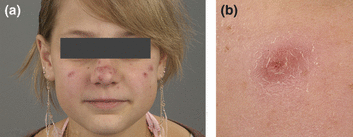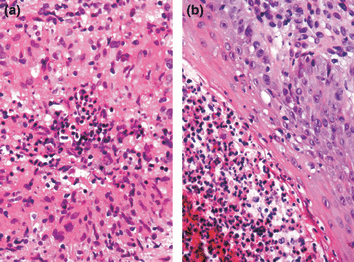Granulomatous rosacea and Crohn’s disease in a patient homozygous for the Crohn-associated NOD2/CARD15 polymorphism R702W
Abstract
Abstract: NOD2/CARD15 belongs to the N-terminal caspase recruitment domain family of proteins involved in regulating NF-kB activation in response to inflammatory stimuli transduced through Toll-like receptors. Mutations and polymorphisms in the NOD2/CARD15 gene reduce antibacterial responses and are associated with granulomatous inflammatory conditions such as Blau syndrome and early-onset sarcoidosis. The polymorphism R702W (arginine to tryptophan) is strongly associated with susceptibility to Crohn’s disease in Caucasian populations. Skin abnormalities (other than cutaneous manifestations of Crohn’s disease) have not been previously associated with R702W. We report on a female patient homozygous for R702W who developed granulomatous rosacea at the age of 12 years old. From the occurrence in the context of Crohn associated with R702W, we speculate that granulomatous rosacea may be an entity distinct from other forms of rosacea, which are associated with increased production of antibacterial proteins such as cathelicidin.
NOD2/CARD15 belongs to the N-terminal caspase recruitment (NACHT) domain family of proteins that are involved in regulating NF-kB activation in response to inflammatory stimuli transduced through Toll-like receptors (1). Mutations and polymorphisms in the NOD2/CARD15 gene are associated with Blau syndrome, Crohn’s disease, atopic dermatitis and early-onset sarcoidosis (2,3). Specifically, the polymorphism R702W (arginine to tryptophan) is strongly associated with susceptibility to Crohn’s disease in Caucasian populations (4). Skin abnormalities (other than cutaneous manifestations of Crohn’s disease) have not been previously associated with this particular mutation. We report on a female patient homozygous for R702W who developed granulomatous rosacea at the age of 12 years old.
The patient, born from non-consanguineous Dutch parents, visited our outpatient clinic for a cutaneous eruption that first appeared about 5 months earlier. She had been diagnosed with Crohn’s disease at age 11 years old. The colitis had been treated with corticosteroids, azathioprine and, more recently, with methotrexate. At the time of her visit, in addition to oral calcium supplements, she used methotrexate and prednisolone in doses of 10 mg weekly and 10 mg daily, respectively. With this regimen, satisfactory disease control had been obtained. Upon dermatological examination, we saw erythematous papules with a diameter of 0.5–1.5 cm, with adherent hyperkeratosis and a central distribution (Fig. 1a,b). Some lesions showed central erosions. Diascopy revealed an apple jelly aspect. Skin elsewhere on the body was normal. We biopsied one lesion. Histopathological examination showed (Fig. 2) dermal granulomata with histiocytes and giant cells, dilated blood vessels and a dense inflammatory infiltrate with lymphocytes, histiocytes and prominent plasma cells. There was no vasculitis and the infiltrate could also be found in a perifollicular distribution.

(a) Erythematous scaling papules with a centrofacial distribution. (b) Detail of a representative lesion.

(a) Histopathology showing granuloma with a dense lymphohistiocytic infiltrate and prominent plasma cells (×40). (b) Perifollicular distribution of the infiltrate (×40).
Based on our clinical and histopathological findings, we made a diagnosis of granulomatous rosacea and proposed treatment with diaminodiphenylsulphone (Dapsone). The patient refused. On re-examination a few months later, the skin lesions had all but disappeared. The granulomatous skin disorder in the context of Crohn’s disease prompted us to examine the patient for NOD2/CARD15 mutations, in view of the known disease associations mentioned above.
Upon obtaining informed consent from the patient and her parents, we isolated DNA from peripheral blood leucocytes using salt precipitation as described elsewhere (5). The NOD2/CARD15 gene was amplified in the patient and both her parents with PCR (primers and conditions available on request). The PCR products were subjected to direct sequencing using the BigDyeDeoxy Terminator system on an ABI3730 capillary sequencer (Applied Biosystems, Nieuwerkerk a/d Ijssel, The Netherlands) as previously described (6). The patient was homozygous for a transition C1406 > T, leading to the substitution of arginine 702 with a tryptophan (R702W). The unaffected parents were heterozygous.
To the best of our knowledge, mutations in NOD2/CARD15 have not yet been described in patients with granulomatous rosacea. It is possible that the skin lesions in our patient represent cutaneous or metastatic Crohn’s disease (7). This possibility was extensively discussed with the dermatopathologist. However, histopathological examination of our patient’s skin lesions did not show significant necrobiosis, vasculitis or neutrophil infiltrates, features that one would expect in cutaneous Crohn (8). Rather, the presence of plasma cells and histiocytes in combination with perifollicular distribution and the deep dermal infiltrate was felt to be consistent with the diagnosis of granulomatous rosacea. The centrofacial distribution of erythematous partly crusted papules was also considered to be more typical of rosacea. Cutaneous metastatic Crohn’s disease tends to present preferentially in flexures or, rarely, as orofacial granulomatosis (9). We do not think that the association between the genetic polymorphism and the granulomatous rosacea is coincidental, as the latter disease typically manifests after the age of 30 years. Our findings might be taken to suggest that granulomatous rosacea is, in fact, a manifestation of Crohn’s disease. In that case, rosacea in general might be hypothesized to be associated with NOD2/CARD15 mutations. R702W is a hypomorphic allele that causes a reduced Toll-like receptor-induced response to bacteria (10). One might thus expect to find, in rosacea, reduced production of antimicrobial peptides. However, recently published data suggest that, in rosacea, increased expression of bactericidal cathelicidins and abnormal processing of this protein into pro-inflammatory peptides contribute to pathogenesis (11). It would therefore seem that rosacea is, at the very least, not associated with hypomorphic NOD2/CARD15 alleles. In support of this notion, production of bactericidal cathelicidin is not increased in Crohn’s disease (12). We therefore suggest that granulomatous rosacea may be a separate entity that belongs to the spectrum of cutaneous findings in Crohn’s disease and might be specifically associated with NOD2/CARD15 polymorphisms or mutations.
It would be of considerable interest to examine the NOD2/CARD15 gene in patients with granulomatous rosacea to further clarify its relation to rosacea in generala.
Acknowledgements
This work was supported by the University Hospital Maastricht, the GROW research institute for growth and development of the University of Maastricht, the Netherlands Organization for Scientific Research (ZONMW grant 907-00-202) and Barrier Therapeutics NV.




